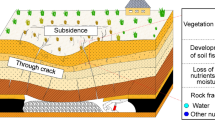Abstract
The efficiency of deep reclamation loosening used for soils of different types on the main parent rocks in the Nonchernozemic zone (mantle and moraine loams, Permian and varved loamy clays, and clays) is assessed basing on the results of long-term stationary and analytical investigations. The long-term aftereffect of the deep loosening on the density, porosity, water permeability, and the main elements of the soil water regime and factors limiting the use of deep loosening are considered. Over 6–12 years after the deep loosening, in the area, where active and passive loosening by a plough was made, a zone of elevated water permeability is preserved at the depth of 40–75 cm. Based on this phenomenon, a new technology of deep reclamation loosening, which restores the hydraulic connection between the arable and deeper soil layers, is proposed. The data on active deep rippers that provide soil loosening to the depth of 0.9–1.0 m are presented. Some agroecological aspects related to the duration of deep loosening effects on the soils and their productivity are discussed. Recommendations on the application of passive and active loosening and moling of heavy-textured gleyed soils are suggested for the European part of the Nonchernozemic zone in the Russian Federation. Field and laboratory works on estimating the efficiency of deep loosening continued for 15 years (1976–1990) for heavy-textured soils on the loess-like, fine-stratified varved clays, as well as on acid moraine and calcareous Permian clays and loamy clays in Moscow, Vologda, Novgorod, and Kirov oblasts.
Similar content being viewed by others
References
Sh. I. Brusilovskii, Reclamation of Heavy-Textured Mineral Soils (Urozhai, Minsk, 1981) [in Russian].
F. R. Zaidelman, Genesis and Ecological Principles of Melioration of Soils and Landscapes (Universitet, Moscow, 2009) [in Russian].
F. R. Zaidelman, “Melioration of heavy wetland soils in the nonchernozemic zone,” Gidrotekh. Melioratsiya, No. 12, 61–66 (1974).
F. R. Zaidelman, Recommendations of Exploration, Planning, and Performance of Construction Works for Deep Meliorative Tillage and Plowing of Soils in the Nonchernozemic Zone of the RSFSR (Glavnechernozemvodostroi, Moscow, 1989) [in Russian].
F. R. Zaidelman and M. E. Ginzburg, “Ecologicalhydrological assessment of deep tillage of drained soils on acid moraine loamy soils,” Pochvovedenie, No. 3, 45–57 (1982).
F. R. Zaidelman, V. A. Zamytskii, V. A. Plavinskii, et al., Ecological and Hydrological Basis for Meliorative Tillage of Soils: Monograph, Ed. by F. R. Zaidelman (Moscow State Univ., Moscow, 1986) [in Russian].
A. P. Kovalev, “Agromeliorative methods for fertility improvement of drained heavy soils,” Gidrotekh. Melioratsiya, No. 12, 58–61 (1979).
I. M. Nesterenko, Land Reclamation in the European North of Soviet Union (Nauka, Leningrad, 1979) [in Russian].
K. F. Podpalyi, A. I. Tyshchenko, and V. S. Danyuk, “The impact of deep tillage on drained lands in Lvov oblast,” Gidrotekh. Melioratsiya, No. 4, 15–18 (1974).
A. N. Stepanov, “Drainage of heavy soils of the Far East,” in Drainage of Heavy Soils (Kolos, Moscow, 1981), pp. 113–122.
H. Yu. Tomberg, “The effect of deep tillage on the water-air soil regime and fertility of agricultural plants in Estonian Soviet Republic,” in Drainage of Heavy Soils (Kolos, Moscow, 1981) [in Russian].
R. L. Turetskii, “Mechanization of agromeliorative works on the heavy mineral soils,” in Drainage of Heavy Soils (Kolos, Moscow, 1981) [in Russian].
V. Ya. Chernenok and Sh. I. Brusilovskii, Deep Tillage of Soils (Kolos, Moscow, 1984) [in Russian].
A. Canarache, “Erhaltung und Verfügbarkeit des Wasser in schweren Böden sowie deren Veränderung durch Tieflockerung,” Tagungsber. -Akad. Landwirtschaftswiss., No. 180, 89–97 (1980).
Z. Cieslinski, “Einflus von Bodengefügemeliorationen auf den Wasserhaushalt von Lös-und Tonböden,” Tagungsber. -Akad. Landwirtschaftswiss., No. 180, 105–120 (1980).
R. Eggelsmann, Dränanleitung (Verlag Paul Parey, Hamburg, 1981).
R. Eggelsmann and H. Kuntze, “Grundregeln für eine bessere Dränwirkung,” Wasser Boden. 32 (5), (1980).
A. Gora, K. Schwarz, and D. Werner, “Verfahrens und Bemessungsgrundlagen fuer die Komplexmelioration staunässer Böden,” in Proceedings of X International Congr. of Soil Scientists “Genesis, Classification, and Geography of Soils” (Nauka, Moscow, 1974), Vol. 10, p.251.
A. L. Lukianas, “Verfahren und Bemessungskriterien für die standort-gerechte Melioration schwerer Böden,” Tagungsber. Akad. Landwirtschaftswiss., No. 180, 47–51 (1980).
L. Martinovic and D. Schröder, “Einflüsse mechanischer und pneumatischer Tieflockerung auf drei Bodentypen. 1. Mitt.: Bodenphysikalische Eigenschaften,” Z. Kulturtechn. Flürberein. 24 (4), 213–223 (1983).
H. Rid and H. Weigel, “Tiefe Lockerung auf Pelosolen,” Bayer. Landwirtsch. Jahrb. 57 (1), 3–17 (1980).
D. Schröder and H. Schulte-Karring, “Nachweis 20-jahriger Wirksamkeit von Tieflockerungsmassnahmen in loss beeinflussten Graulehm–Pseudogleyen,” Z. Pflanzenernähr. Bodenkd. 147 (5), 540–552 (1984).
H. Schulte-Karring, Die Meliorative Bodenbewirtschaftung—Anleitung zur Fachgerechten und Nachhaltigen Verbesserung von Staunässebüden (Ahrweiler, 1970).
K. Schwarz and A. Gora, “Meliorationsmöglichkeiten mit Hilfe eines kombinierten Tieflockerungs-und Tiefkalkungsgeräts,” Dtsch. Agrartech. 13 (3), (1963).
V. H. Weigelt, “Einflus unterschiedlicher Meliorationsverfaren auf Pflanzenertrag und Bogeneigenschaften einer schwach pseugldovergleyten Parabraunerde aus Loslehm,” Bayer. Landwirtsch. Jahrb. 58 (7), 771–728 (1980).
D. Werner, “Feuchtedynamik einer Lös–Fahlerde nach Gefügemelioration,” Arch. Acker-Pflanzenbau Bodenkd. 24 (11), 695–708 (1980).
Author information
Authors and Affiliations
Corresponding author
Additional information
Original Russian Text © F.R. Zaidel’man, 2016, published in Pochvovedenie, 2016, No. 9, pp. 1131–1146.
Rights and permissions
About this article
Cite this article
Zaidel’man, F.R. Deep reclamation loosening of soils: State of the problem, results of research, prospects of application, and degradation changes. Eurasian Soil Sc. 49, 1061–1074 (2016). https://doi.org/10.1134/S1064229316070139
Received:
Published:
Issue Date:
DOI: https://doi.org/10.1134/S1064229316070139




